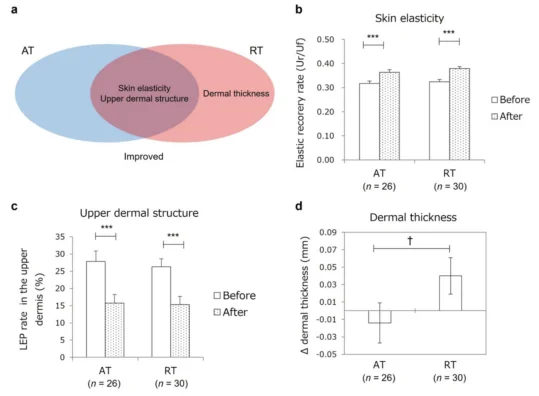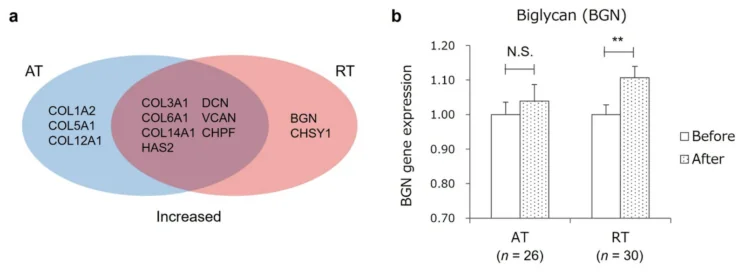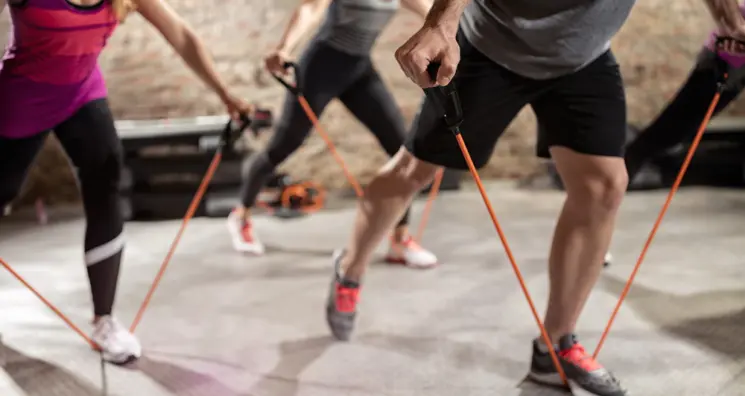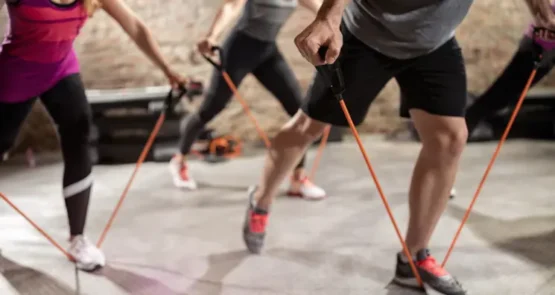According to a new study published in Nature Scientific Reports, while both aerobic and resistance exercise improve some aspects of skin aging, only the latter is able to increase skin thickness [1].
Exercise and skin – an overlooked connection
Skin is the largest organ of the human body, providing a barrier that keeps us safe from environmental hazards, such as pathogens, sun rays, and pollution – which also means that skin is one of the first organs to start aging. Skin aging is characterized by skin thinning, extracellular matrix degradation, and increased cellular senescence.
Exercise is an essential part of any life extension strategy. Its health benefits are numerous, and new discoveries keep coming. However, the role of exercise in skin aging has been largely overlooked. While one study found that aerobic exercise lowers IL-15, a regulator of skin aging [2], the effects of resistance training on skin aging are basically unknown.
In thickness and in health
In this new paper, the researchers describe a 16-week, randomized study in 61 healthy sedentary middle-aged Japanese women. The participants were divided into two groups, one put on an aerobic training regimen (AT) and the other on a resistance training regimen. Blood samples were taken from participants before and after the intervention.
Both interventions did what they were supposed to do: AT significantly decreased body weight and body mass index (BMI) and significantly improved peak oxygen uptake (VO2peak), a measure of aerobic capacity, while RT increased lean mass and muscle strength.
With regard to skin aging, both AT and RT improved skin elasticity and upper dermal structure. However, only RT increased dermal thickness.

To explore the mechanisms by which the interventions improved skin aging, plasma from blood sampled at rest before and after the 16-week training was added to cultured human dermal fibroblasts, and the expression of dermal genes related to the extracellular matrix (ECM) was analyzed.
Here, the difference between the two types of training was evident as well. Both AT and RT improved the expression of numerous ECM-related genes, such as those involved in collagen production, but the overlap was incomplete. AT affected more collagen-related genes, while RT affected biglycan, a protein that interacts with collagen fibers in the ECM, contributing to the structural integrity of tissues.

Since biglycan was one of only two proteins affected solely by RT, and it has been linked to skin health by previous research (genetically modified mice with impaired biglycan production are known to have thinner skin) [3], the researchers focused on this factor.
Exercise clearly affects expression of genes in skin cells via circulating factors. The researchers measured 1480 of them and found three that were negatively correlated with the post-RT increase in biglycan levels. Incidentally, all those factors are known to be pro-inflammatory. When applied to human dermal fibroblasts in vitro, the three factors caused a decrease in biglycan levels. However, the researchers admit that animal studies are needed “to clearly confirm the skin rejuvenating mechanism of RT.”
In conclusion, a 16-week intervention with AT and RT showed that both training interventions counteract skin aging by improving skin elasticity and upper dermal structure. In addition, RT increases dermal thickness by inducing a reduction in circulating levels of CCL28, N,N-dimethylglycine, and CXCL4 and thus suppressing expression of dermal BGN (Fig. 5). The study clarified only the mechanism by which RT counteracts age-associated dermal thinning, and the other mechanisms of AT- and RT-driven skin rejuvenation remain to be elucidated.
Both kinds are valuable
The main upshot of this study is that both types of exercise are needed to maximize the positive effect on skin health. However, this is not the only reason to integrate both aerobic and resistance training into a routine. The former is notably better at maintaining a healthy weight and metabolism, while the latter is known to help maintain muscle mass, which is crucial for healthspan.
Literature
[1] Nishikori, S., Yasuda, J., Murata, K., Takegaki, J., Harada, Y., Shirai, Y., & Fujita, S. (2023). Resistance training rejuvenates aging skin by reducing circulating inflammatory factors and enhancing dermal extracellular matrices. Scientific Reports, 13(1), 10214.
[2] Crane, J. D., MacNeil, L. G., Lally, J. S., Ford, R. J., Bujak, A. L., Brar, I. K., … & Tarnopolsky, M. A. (2015). Exercise-stimulated interleukin-15 is controlled by AMPK and regulates skin metabolism and aging. Aging cell, 14(4), 625-634. Chicago
[3] Corsi, A., Xu, T., Chen, X. D., Boyde, A., Liang, J., Mankani, M., … & Young, M. F. (2002). Phenotypic effects of biglycan deficiency are linked to collagen fibril abnormalities, are synergized by decorin deficiency, and mimic Ehlers-Danlos-like changes in bone and other connective tissues. Journal of Bone and Mineral Research, 17(7), 1180-1189.





